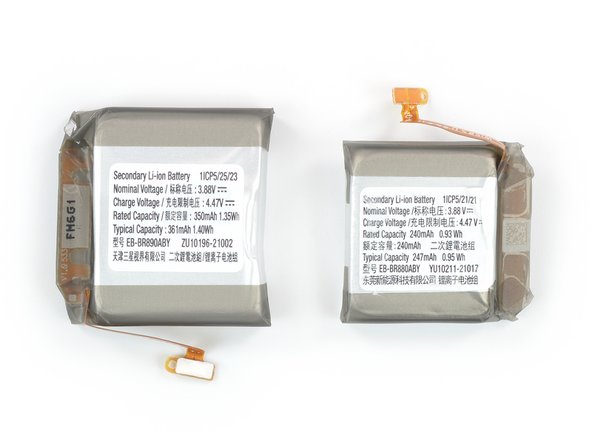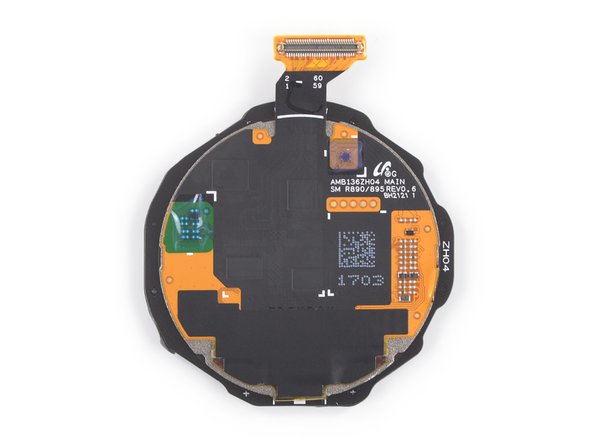Samsung Galaxy Watch4 Classic Repair Guide: Step-by-Step DIY Teardown
Duration: 45 minutes
Steps: 9 Steps
Samsung’s back with the Galaxy Watch4 and Watch4 Classic, looking pretty similar to last year’s model—at least on the outside. But what’s really going on under the hood? Let’s crack one open and find out! Ready for a teardown adventure? Grab your tools, and let’s see what makes the latest Galaxy tick.
Step 1
– Time to dive into the specs and see what these fresh Samsung wearables bring to your wrist:
– Exynos W920 1.18 GHz chip with dual ARM Cortex-A55 cores, low-power Cortex-M55 display processor, Mali-G68 GPU, and integrated LTE—ready for all your wrist’s needs!
– A sleek Circular Super AMOLED display with always-on functionality—choose between 1.19 inch or 1.36 inch sizes, both with sharp 330 PPI.
– 1.5 GB RAM and 16 GB internal memory—perfect for all your wearable essentials.
– Battery life breakdown: a 361 mAh in the larger models, like the Watch4 Classic (46 mm), and a 247 mAh in the smaller Watch4 (40 mm). Stay charged!
– Packed with sensors: accelerometer, barometer, gyro, geomagnetic, light, optical heart rate, ECG, bioelectrical impedance sensor, and a Hall sensor on the Classic.
– IP68 rating, which means water-resistant to 50 meters (5 ATM)—bring it on, water!
Step 2
– While the Galaxy Watch4 and Galaxy Watch4 Classic share almost identical specs, each one brings its own distinct flair:
– The Watch4 Classic keeps the beloved rotating bezel from the Watch3 and has a bit of a beefier feel. If you’re after something sleeker, the standard Watch4 channels a vibe closer to Samsung’s Active line or even the Xiaomi Mi Watch 2021.
– The Galaxy Watch4 always comes in aluminum, but the Classic gives you more sophisticated options for the frame: 316L stainless steel or titanium (yes, just like the ones used in space!).
Step 3
– Before diving into opening up your devices, let’s do a quick side-by-side comparison with the Watch3—our trusty predecessor—to spot any differences: The new Watch4 models, both standard and Classic, rock sleek, rectangular buttons instead of the round ones from the Watch3. Also, the back of the Watch4 features the fresh Bioelectrical Impedance Analysis sensor, but don’t worry—it doesn’t alter the hardware layout. The main thing to note is that the service port hatch you’d find at the top of the Watch3 (see the third photo, center) is missing on the Watch4. Keep these differences in mind as you proceed with your repair.
Step 4
Thinking there’s a trick here? Nope—no heat guns or risky blade action required. The rubber gasket does all the work, holding things sealed tight and keeping that IP68 rating intact. Nice and easy!
– After all that careful exploration of the outside, it’s time to get inside these watches. Both models open from the back, just like the Watch3: four tri-point screws are in the way, but a specialty driver makes quick work of them. Then, a gentle pry with an Opening Tool and you’re in. Compared to the more integrated rear of the Watch3, the Watch4 reveals a few more components to remove early on: the flex cables and what looks like a wire for body composition measurement. The only silicon here is the Texas Instruments AFE4500S, which takes care of the optical biosensing.
Step 5
– If you’re curious about the tiny biosensing chip from the previous step, get ready for more chip adventures! Carefully unscrew and gently pry off the motherboard—on the left, you’ll find the Watch4 Classic, and on the right, the Watch4. Inside, you’ll see Samsung’s combo package featuring the Exynos W920 dual-core 1.18 GHz processor alongside what appears to be 1.5 GB of their custom LPDDR4 RAM. Also, check out the Samsung Shannon 915 intermediate frequency IC, the Broadcom BCM43013 ultra-low-power dual-band 802.11n Wi-Fi and Bluetooth 5.0 combo IC, and the Qualcomm Atheros QPA5580 power amplifier (most likely). If you need help at any point, you can always schedule a repair.
Tools Used
Step 6
– Here’s a fun update: The back of the Watch4 Classic motherboard doesn’t reveal much, but the Watch4 shares a couple more of those familiar chips. We suspected from the datasheets that these watches are quite similar, and it turns out — they really are. Silicon-wise, there’s nothing that sets them apart. Keep that in mind as you work through the repair, and if you hit a tricky spot, you can always schedule a repair for some extra help. Happy fixing!
Step 7
– The watch’s fuel tanks are cleverly tucked away beneath the motherboards and nestled within plastic midframes, making them a bit sneaky to find. The Watch4 Classic 46 mm packs a 1.40 Wh (361 mAh @ 3.88 V) battery, while its smaller sibling, the 40 mm Watch4, sports a 0.95 Wh (247 mAh @ 3.88 V) battery—compact but powerful! We gently shake loose the last components from the midframe and spot a familiar vibration motor sitting right next to the barometric sensor. The real star here is the button flex cable. Not only does it carry a microphone for snore-tracking, but it also features an extra contact plate opposite its connector. This setup allows the watch to complete an electrical circuit through your body for bioelectric impedance analysis. If you need help, you can always schedule a repair.
Good news—both batteries can come out without any heat, as long as you’ve got a sturdy spudger ready to go. Just remember, poke gently—no need to go full ninja, and stick to the usual li-ion battery caution. On the power front, the 2021 Mi Watch with 1.62 Wh offers a bit more juice than the Watch3’s 1.3 Wh (340 mAh at 3.85 V). Meanwhile, the Apple Watch Series 6 (44mm) trails behind with 1.17 Wh, so there’s a modest upgrade if you’re comparing these models side by side. If you need help, you can always schedule a repair.
Tools Used
Step 8
– Most Galaxy watches we see are pretty friendly when it comes to screen repairs—unlike some other smartwatches. The Galaxy Watch4 series keeps that trend going, at least halfway. The Watch4 Classic is straightforward: a gentle heat and a quick push with your finger can lift the circular AMOLED screen from the frame. But the standard Watch4? Not so much. You’ll need some heating and prying tools to get that screen off. Be prepared for a cracked display glass and a toasted yellow AMOLED underneath. Luckily, removing the screen usually doesn’t block access to other parts of the watch—if you’re prying it off, chances are it’s already broken. If you need help, you can always schedule a repair.
Step 9
Good news—most of the parts you’ll need are a breeze to get your hands on. The only exception is the Watch4 screen, which can be a bit tricky. Overall, the key repairs are straightforward and won’t have you pulling your hair out, especially compared to fixing up Samsung’s Galaxy phones.
– Tick-tock, it’s time to wrap up our adventure. Another journey through two Galaxies has come to a close, and look at all the treasures we’ve gathered along the way.
– The clock’s run out—let’s see how these watches stack up on our reparability scale!
Success!























